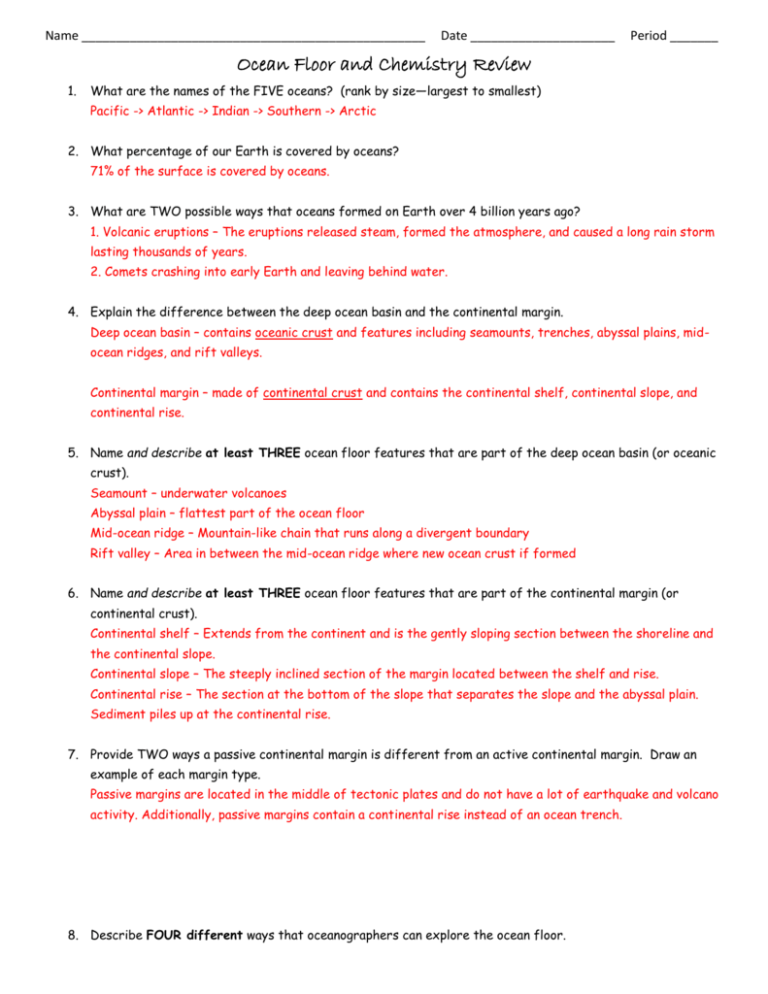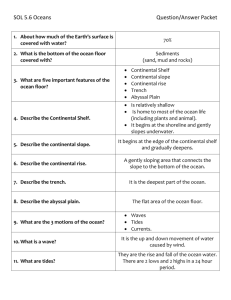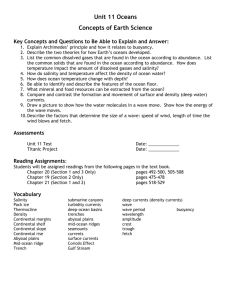Click here for answers!
advertisement

Name __________________________________________________ Date _____________________ Period _______ Ocean Floor and Chemistry Review 1. What are the names of the FIVE oceans? (rank by size—largest to smallest) Pacific -> Atlantic -> Indian -> Southern -> Arctic 2. What percentage of our Earth is covered by oceans? 71% of the surface is covered by oceans. 3. What are TWO possible ways that oceans formed on Earth over 4 billion years ago? 1. Volcanic eruptions – The eruptions released steam, formed the atmosphere, and caused a long rain storm lasting thousands of years. 2. Comets crashing into early Earth and leaving behind water. 4. Explain the difference between the deep ocean basin and the continental margin. Deep ocean basin – contains oceanic crust and features including seamounts, trenches, abyssal plains, midocean ridges, and rift valleys. Continental margin – made of continental crust and contains the continental shelf, continental slope, and continental rise. 5. Name and describe at least THREE ocean floor features that are part of the deep ocean basin (or oceanic crust). Seamount – underwater volcanoes Abyssal plain – flattest part of the ocean floor Mid-ocean ridge – Mountain-like chain that runs along a divergent boundary Rift valley – Area in between the mid-ocean ridge where new ocean crust if formed 6. Name and describe at least THREE ocean floor features that are part of the continental margin (or continental crust). Continental shelf – Extends from the continent and is the gently sloping section between the shoreline and the continental slope. Continental slope – The steeply inclined section of the margin located between the shelf and rise. Continental rise – The section at the bottom of the slope that separates the slope and the abyssal plain. Sediment piles up at the continental rise. 7. Provide TWO ways a passive continental margin is different from an active continental margin. Draw an example of each margin type. Passive margins are located in the middle of tectonic plates and do not have a lot of earthquake and volcano activity. Additionally, passive margins contain a continental rise instead of an ocean trench. 8. Describe FOUR different ways that oceanographers can explore the ocean floor. Name __________________________________________________ Date _____________________ Period _______ 1. Satellite – measure the height of the ocean water to develop a map of the ocean floor 2. SONAR – send sound waves to measure the depth of the ocean floor 3. Piloted vessels – Controlled by an on-board pilot/explores smaller sections of the ocean floor 4. Robotic vessels – controlled on the surface/can go to areas that are difficult to access 9. Explain why the ocean is salty and remains salty. The ocean is continuously being provided with sediments weathering and eroding from rivers and streams. This sediment is deposited in the ocean and remains there overtime. 10. Which is more dense—salt water or fresh water? Explain. Salt water because it has more mass. 11. How do we measure the specific gravity (density) of water? Specific gravity is measured by using a hydrometer to see the salinity and density of the water. 12. What is salinity? How is it measured? Salinity is the amount of dissolved salts in a given amount of liquid. It is measured in ppt (parts per thousand) using an instrument called a hydrometer. 13. How do the following factors affect the salinity of water? a. High rate of evaporation – Increased salinity b. Slow moving water – Increased salinity c. Addition of fresh water (ex. A river flowing into a bay) – Decreased salinity 14. Briefly describe the THREE temperature zones of the ocean. 1. Surface zone – Uppermost region of the ocean/warmest layer/also called the “mixed layer” because waves mix the water. 2. Thermocline – The region in which we see the most drastic drop in temperature as depth increases. 3. Deep zone – Deepest and coldest layer because sunlight cannot reach these depths/”polar creep” ocean current. 15. How does each one change with latitude? Low latitudes (tropics/equator) – warmest surface zone/most drastic change in temperature Mid latitudes – Changes based on seasons/surface zone warmer in summer High latitudes (polar) – all three zones around the same temperature/no drastic thermocline Name __________________________________________________ Date _____________________ Period _______ Name __________________________________________________ Across: 6. sunlight 9. deep 11. decreases 13. Geosat 18. Freshwater 19. trench 20. active 21. Medea 22. increase 23. salinity 24. shelf Down: 1. margin 2. passive 3. Alvin 4. Challenger 5. Slope 7. hydrometer 8. seamount 10. SONAR 12. surface 14. Dead 15. density 16. thermocline 17. polar Date _____________________ Period _______







